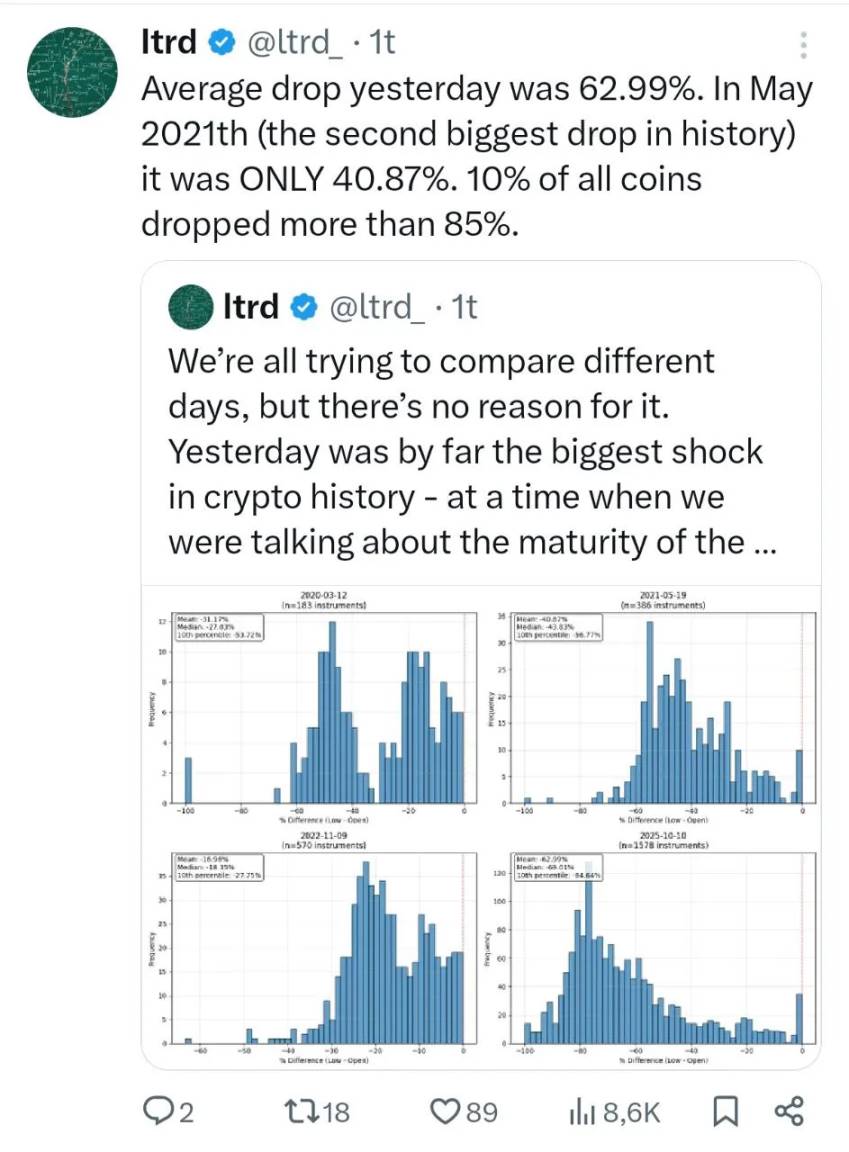What Should Cryptocurrency Investment Look Like in the Post-Crash Era?
Written by: Route 2 FI
Translated by: Saoirse, Foresight News
Editor’s Note: When the cryptocurrency market experienced the cliff-like crash on "10.11," with altcoins plummeting an average of 62%, the author reflects on survival logic from a firsthand perspective: from the unexpected safety of a delta-neutral strategy to a deep reflection on the use of leverage and market speculation. The article reveals the pressure tests faced by DeFi and perpetual contract platforms, while also posing the core proposition of "passion-driven industry survivors." Below is the full translation:
I have been reflecting on my life choices lately—over the past four years, I have devoted almost all my energy to the cryptocurrency field, and this "devotion" is no exaggeration: I have had almost no other hobbies, and most of my waking hours revolve directly or indirectly around cryptocurrency: researching trades, testing new protocols, communicating with others, posting content on platform X, reading others' opinions, browsing industry newsletters, and reviewing podcast transcripts (I prefer text because I can read five times faster than watching videos or listening to audio).
I genuinely love the process of hard work, and I could even say I am somewhat obsessed. This does not mean that cryptocurrency is my only interest, but it is indeed my core focus at the moment. Perhaps one day in the future I will feel bored and spend weeks or months contemplating my life direction, ultimately finding a new goal. But looking back, my obsession with numbers and speculation is indeed evident.
The crash on "10.11" was shocking, but I emerged almost unscathed. Over the weekend, I employed a delta-neutral strategy on the Lighter platform, and my short positions were not automatically liquidated like they were on platforms such as Hyperliquid; on the long side, I only held spot assets. At that time, I had not opened any perpetual contract positions on Bybit, and the day before the crash, I closed a sizable DOGE/BTC pair trade—my initial intention was simply to enjoy a worry-free weekend. In hindsight, had I not closed that trade, I would have likely suffered significant losses. So, my survival this time indeed involved a bit of luck.
I typically use low leverage of 2-3 times to reduce the margin required on centralized exchanges (CEX) or decentralized exchanges (DEX). However, this crash still shocked me: altcoins averaged a drop of 62%, with some coins plummeting 85%-99%—which means all leveraged long traders have been "liquidated." Over the past few years, many aggressive traders (known in the community as "degens") have flooded into the cryptocurrency trading market, first battling in the Solana space and then venturing into perpetual contracts. Now, leveraged trading has become the norm in the industry, and I use leverage daily as well. Some may blame these traders for lacking risk management awareness, but in my view, 2-3 times leverage is actually quite conservative. To be honest, I believe people will not give up leverage because of this crash—within 1-2 weeks, those aggressive traders will return to the market as if nothing has happened.
Imagine facing an average drop of 63% in altcoins (and this is just the average; most coins have dropped much more), how would you hedge your risks? It’s simply insane.

So, after experiencing this crash, who will remain in this cycle to continue "fighting"?
The answer is those who are "stubborn and cautious": they mainly hold spot assets and will observe new coins or projects for a long time before daring to invest. They do not blindly follow trends to "go all in," so they usually cannot achieve super high returns, but at the same time, their portfolios can achieve stable compound growth year after year.

The hardest hit were perpetual contract traders; ironically, many "altcoin diehards" (such as traders in the Solana space) are relatively better off—because most of them engaged in non-leveraged trading. Of course, some did venture into the perpetual contract market, and if that’s the case, they have likely suffered heavy losses. But most still hold the "spot position," and even if they incur losses, they are not completely wiped out.
For perpetual contract decentralized exchanges (Perp DEX), the impact of this crash is worth noting: the short positions on the Hyperliquid platform were automatically liquidated, allowing its platform token HLP to profit; while the short positions on the Lighter platform were not liquidated, leading to losses for its platform token LLP. No one can predict the future of perpetual contract decentralized exchanges, but this "10.11" "stress test" has left many lessons and areas for improvement for the industry. For example, does the buyback model of the HYPE token need adjustment? Is 100% buyback sustainable?
Will I stop using leverage? The answer is no. I know I must take responsibility for all trades and decisions; risk is always present—if there is no risk, it means there are no potential gains.
Regarding the DeFi space, I expect there will be a wave of position liquidations in the future. Although DeFi performed well during the "10.11" crash, market panic has spread, and many may prefer to store their assets in their own wallets rather than entrusting them to third parties. Fortunately, USDe remained stable during this event. In my view, Ethena is the "pillar" of the DeFi space—it supports the entire DeFi ecosystem, and if Ethena encounters problems, it will trigger a chain reaction (for example, 70% of Pendle's total locked value (TVL) relies on Ethena).
Looking ahead, I have been thinking about which altcoins are worth buying. Currently, I am more inclined towards MNT and those long-standing "old tokens." Additionally, I believe the "altcoin speculation frenzy" will cool down in the future, so PUMP and Fartcoin will not become my main investment targets. At present, I mainly hold stablecoins and plan to adopt a "pure news/narrative-driven" trading model—this model may not yield the highest returns, but at least it can protect my account funds well in the short term.
Finally, I want to say:
Most people cannot achieve their dream wealth goals because they do not possess the qualities of successful individuals.
The competitors you face are those who are "born for this field": they do not care about working hours and do not back down in the face of difficulties. They do not slack off in good times, nor do they give up in bad times—this has long become their rhythm of life.
Wealth may be their superficial goal, but what truly drives them is "the process of pursuit," "the joy of growth," "the honing of skills," and the silent improvement of professional abilities when no one is watching.
They are not obsessed with the "finish line," but deeply love "the scenery along the way."
Because of this, when others choose to become weary or withdraw, they can still continue to "win"—not because they "must win," but because they cannot imagine leaving this "game" they love.
免责声明:本文章仅代表作者个人观点,不代表本平台的立场和观点。本文章仅供信息分享,不构成对任何人的任何投资建议。用户与作者之间的任何争议,与本平台无关。如网页中刊载的文章或图片涉及侵权,请提供相关的权利证明和身份证明发送邮件到support@aicoin.com,本平台相关工作人员将会进行核查。




